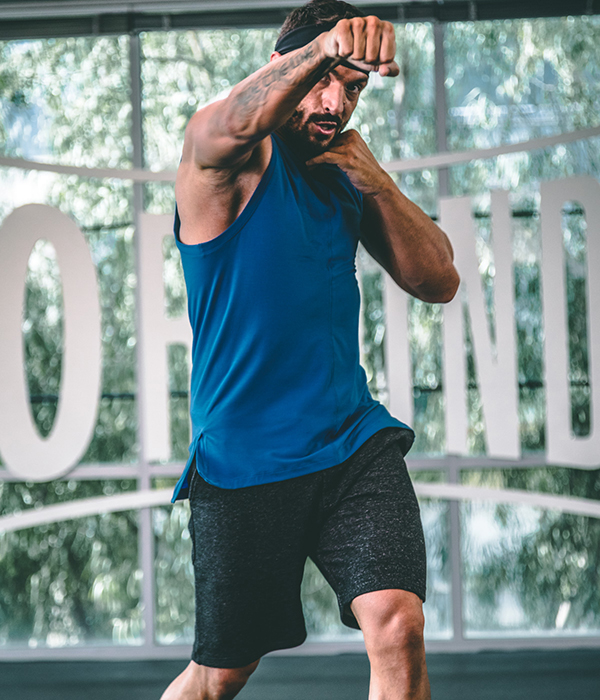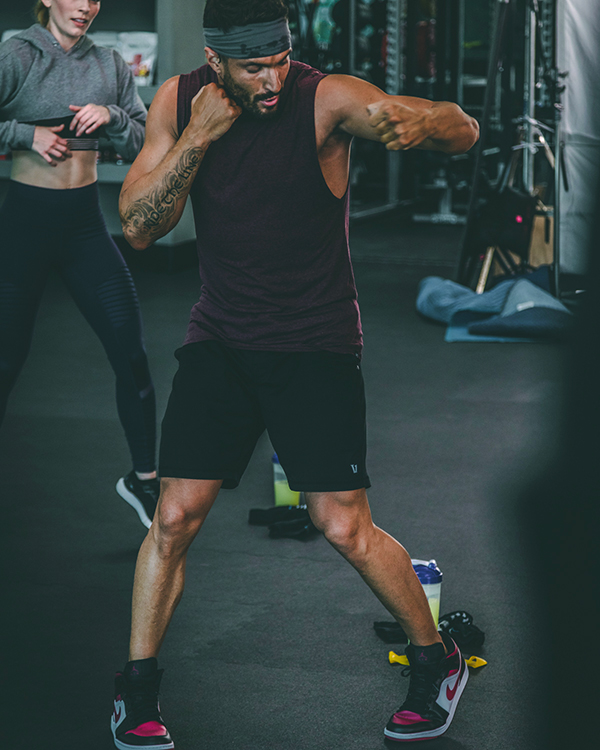The 10 Rounds Glossary

If you’ve ever wanted to learn how to box — or just learn how to throw a punch — get ready to duke it out because 10 Rounds is here.
10 Rounds with Joel Freeman is a six-week program that will teach you the fundamentals of boxing: proper boxing stance, how to punch, combinations, footwork, plus weightlifting workouts to help power your punches.
10 Rounds is a total-body boxing workout. And there’s no need for boxing gloves or a sparring partner; you’ll be shadowboxing.
But first — get to know some of the basic boxing terms Joel will be using throughout the program.

Boxing Stance
Before you channel your Rocky Balboa and start throwing knuckle sandwiches, it’s important to get your boxing stance right.
Why? For power and stability.
A proper boxing stance generates power for your punch and helps you maintain your balance.
Every punch actually starts with your feet, gaining momentum and power as it moves through your hips and core as you rotate your body and finally unleash it.
Your body is positioned opposite your “handed”-ness — a righty will stand with the left arm and left leg in front (orthodox stance), and a lefty will stand with the right arm and right leg leading (southpaw).
To get into an orthodox boxing stance:
1. Start with your feet parallel, about shoulder-width apart. Take a step back with your right foot and keep the knees slightly bent. Imagine a perpendicular line on the floor right beneath you — one foot should be on each side of the line, not lined up right behind each other.
2. Angle your front foot so it’s pointing slightly to the right, not straight ahead. Angle your rear foot further out, at about 45 degrees.
3. Bring your hands close to your chin with the palms facing in and making a soft fist. Your elbows should be down, tucked in toward your ribcage, shoulders relaxed away from your ears.
If you’re a southpaw, follow the directions in reverse so that your right arm and right leg are in the “front” position.
Fun fact: Only about 10% of people are left-handed. Using “southpaw” to describe a left-handed punch may have originated as far back as the 1800s.
To keep things short and sweet, the directions below describe how to throw a punch from an orthodox stance (sorry, lefties!).
How to Throw a Punch
There are many different types of punches (and variations of those punches) in boxing.
We don’t want to steal Joel’s thunder, so here are four basic punches you’ll be throwing (a LOT) in 10 Rounds: jab, cross, hook, and uppercut.

1. Jab
A jab is a fast punch that you throw with your front arm. It’s a straight shot forward, so there’s not a lot of hip movement.
How to throw a jab:
- From your boxing stance, step forward with your front leg as you punch your front arm straight out. Your rear fist remains on guard near your chin.
- As you punch out, rotate your arm and fist clockwise so that the top of your knuckles are facing up, palm/thumb facing down by the time your arm is fully extended.
- Pull your arm back in quickly and step back to reset your stance.

2. Cross
A cross is a punch that you throw with your rear arm. For this one, you’ll be rotating your hips to create more power.
How to throw a cross:
- From your boxing stance, rotate your back hip forward, bringing up your rear heel and pivoting on the ball of your foot, and punch straight out with your back fist. Your lead fist remains on guard near your chin.
- Similar to the jab, rotate your arm so that the top of your knuckles face up, palm/thumb face down by the time your arm is fully extended.
- Pull your arm back in quickly and rotate your hips back to your boxing stance to reset.
3. Hook (Front and Rear)
A hook is a punch that you throw with your front OR rear arm, moving out and forward in a semicircular “hook” shape rather than straight out.
There are two versions of the hook: front hook with your front arm, rear hook with your rear arm.
How to throw a front hook:
- From your boxing stance, turn your front hip inward, lift up your front heel and pivot on the ball of your foot.
- With your lead arm, instead of punching straight out, raise your left elbow out to the side, bent at 90 degrees, so it’s horizontal with your fist. Rotate your torso and hips as you throw your punch in an arc toward the side of your opponent’s head.
- Reverse the motion by rotating the hips back to your boxing stance and bringing your fist back to your guard.
Pro tip: Don’t swing your arm out wide; this is a compact punch.

4. Uppercut (Front and Rear)
An uppercut is a punch you throw with your front OR rear arm in an upward motion, toward the bottom of your opponent’s chin.
How to throw an uppercut:
- From your boxing stance, shift your weight into your front hip by rotating the hips to the left and dropping your front hip and shoulder slightly.
- Then rotate your hips to the right. The heel of your front leg comes off the floor as you extend your left hip forward. Drive your left fist up and away from you in an arc with your palm facing you, aiming for the bottom of your opponent’s chin.
- Reverse the movement to come back to your boxing stance and bring your left hand back to a guard.

Footwork and Defense
In order to “float like a butterfly and sting like a bee,” in the words of boxing great Muhammad Ali, you need to master footwork, which is a key part of boxing training.
You’ll learn footwork moves like the L-drill, half fan, full fan, shuffle, and pivot.
Joel will also be teaching you the fundamentals of defense — moves to avoid punches with a slip or roll, so you can get yourself in position to throw them.

